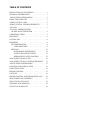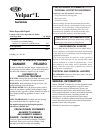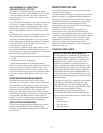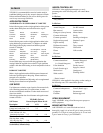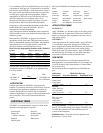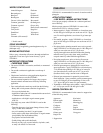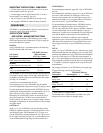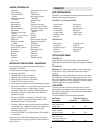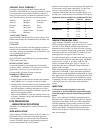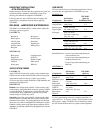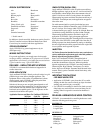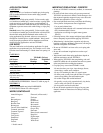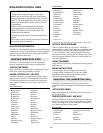
ENVIRONMENTAL CONDITIONS
AND BIOLOGICAL ACTIVITY
VELPAR L is absorbed through the roots and foliage.
Moisture is required to activate VELPAR L in the soil. Best
results are obtained when the soil is moist at the time of
application and 1/4–1/2" of rainfall occurs within 2 weeks
after application.
Apply VELPAR L preemergence or postemergence when weeds
are less than 2" in height or diameter. Foliar activity is most
effective under conditions of high temperature (above 80 °F),
high humidity, and good soil moisture. Foliar activity may be
reduced when vegetation is dormant, semi-dormant, or under
stress.
On herbaceous plants, symptoms usually appear within 2 weeks
after application under warm, humid conditions, while 4–6
weeks may be required when weather is cool or dry, or when
plants are under stress. If rainfall after application is inadequate
to activate VELPAR L in the soil, plants may recover from
contact effects and continue to grow.
On woody plants, symptoms usually appear within 3–6 weeks
after sufficient rainfall has carried the herbicide into the root
zone during periods of active growth. Defoliation and refoliation
may occur, but susceptible plants are killed.
The degree and duration of control may depend on the following:
• Use rate
• Weed spectrum and size at application
• Environmental conditions at and following treatment
Where a rate range is shown, use the higher levels of the dosage
range on hard-to-control species, fine-textured soils, or soils
containing greater than 5% organic matter or carbon. Use the
lower levels of the dosage range on coarse-textured soils and/or
on soils low in organic matter. Refer to specific uses for rate
ranges.
WEED RESISTANCE MANAGEMENT
When herbicides with the same mode of action are used
repeatedly over several years to control the same weed species
in the same field, naturally occurring resistant weed biotypes
may survive a correctly applied herbicide treatment, propagate,
and become dominant in that field. These resistant weed
biotypes may not be adequately controlled. Cultural practices
such as tillage, preventing weed escapes from going to seed, and
using herbicides with different modes of action within and
between crop seasons can aid in delaying the proliferation and
possible dominance of herbicide resistant weed biotypes.
APPLICATION INFORMATION
VELPAR L may be applied by ground equipment and, where
permitted, aerial equipment. Use rates, minimum spray
gallonage, and other application information are described for
the various uses.
DIRECTIONS FOR USE
It is a violation of federal law to use this product in a manner
inconsistent with its labeling.
VELPAR L should be used only in accordance with recommen-
dations on this label, or in supplemental DuPont publications.
Do not apply this product in a way that will contact workers or
other persons, either directly or through drift. Only protected
handlers may be in the area during application. For any
requirements specific to your state or tribe, consult the agency
responsible for pesticide regulation.
The correct use rates by crop and geographical area,
specified on this label, and proper mixing/loading site
considerations and application procedures must be followed
to minimize potential for hexazinone movement into ground
water. Users are encouraged to consult with their state
Department of Agriculture, Extension Service, or other
pesticide lead agency for information regarding soil
permeability, aquifer vulnerability, and best management
practices for their area.
AGRICULTURAL USES
AGRICULTURAL USE REQUIREMENTS
Use this product only in accordance with its labeling and
with the Worker Protection Standard, 40 CFR part 170.
This Standard contains requirements for the protection of
agricultural workers on farms, forests, nurseries, and
greenhouses, and handlers of agricultural pesticides. It
contains requirements for training, decontamination, notifi-
cation, and emergency assistance. It also contains specific
instructions and exceptions pertaining to the statements on
this label about personal protective equipment(PPE) and
restricted-entry interval. The requirements in this box only
apply to uses of this product that are covered by the Worker
Protection Standard.
Do not apply this product in a way that will contact workers
or other persons, either directly or through drift. Only
protected handlers may be in the area during application.
Do not enter or allow worker entry into treated areas during
the restricted entry interval(REI) of 24 hours.
PPE required for early entry to treated areas that is
permitted under the Worker Protection Standard and that
involves contact with anything that has been treated, such as
plants, soil, or water, is :
Coveralls
Waterproof gloves
Shoes plus socks
Protective eyewear
2




